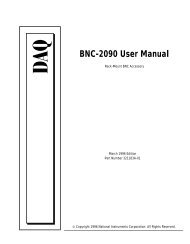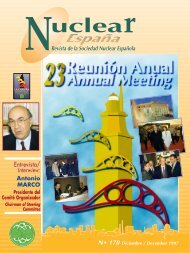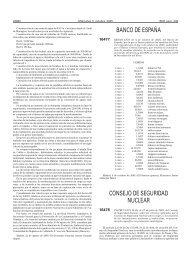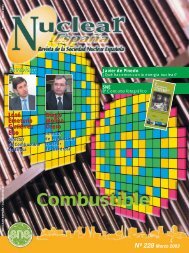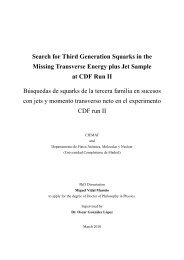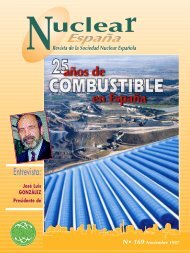Create successful ePaper yourself
Turn your PDF publications into a flip-book with our unique Google optimized e-Paper software.
een reduced to 24 days in 1994, and the aim is toreduce this figure even more in the near future.STEAM GENERATORREPLACEMENTMr. Philippe Gustin, Vice-President of Dampierre NPP,described the history of steam generator replacement inEDF plants and how the experience gained has beenapplied to the Dampierre 3 plant (900 MW - PWR).It should be noted that, in France, SG replacements(SGR) are scheduled at the national level. Our nuclearcapacity is organized so as to allow one or tworeplacements a year. Dampierre 1 was followed by SGRson Bugey 5 in 1993, then on Gravelines 1 in 1994. Therate is now accelerating; the SGs of St. Laurent B1 werereplaced in the second half of 1995, and after Dampierre3 it will be the turn of Gravelines 4.Replacements are of course scheduled according to:- the plugging rate, existing and foreseeable in themedium term;- the types of defects found in the SG tubes.In Dampierre 3, the main defects found reflected stresscorrosion in the primary side, in the expansion transitionzone. It should also be noted that secondary corrosion ofthe tube support plates has been showing since 1993.SG replacement strategy in France is aimed at extendingpower station life. Our current knowledge of the mainitems of equipment allows us to anticipate a working life offorty years.The large components are replaced in the context of thisstrategy. In the case of the SG, it was decided that thereplacement equipment would be identical except for thegrade of metal used in the tubes, changed form Inconel600 to Inconel 690.The replacement was performed in the following context:- SGR was performed during a normal unit outage(partial inspection).- The outage also provided an opportunity to change thecondenser modules and fit the condenser with stainlesssteel tubes in place of cupro-nickel tubes.- A set of safety-related modifications called the “93upgrade” was retrofitted to the unit during the outage.- Whereas the SGRs prior to the disconnection of theSGs from the primary circuit involved SG tube bundles,the Dampierre 3 SGR included a world “first”: fiveelbows were changed at the same time as the SGs.In figures:The implementation stage fits into a unit outage that lastsabout 3 months. The SGR itself (from the first cutting tothe end of the hydraulic test) is scheduled for forty-twodays in 7-day weeks.The SGR operation requires an investment of about 3hundred thousand hours of work, broken down amongEDF, the builder Framatome, and various subcontractors.The implementation takes one hundred twenty thousandhours of work during the outage. The site was host tofifteen hundred people working for outside contractors, inaddition to the usual eleven hundred EDF employees atthe site.The outage of unit 3 was scheduled for one hundred andten days. Decoupling was on 4 November 1995, andrecoupling was scheduled for mid-February.The Dampierre 3 SGR made full use of operatingfeedback from earlier SGRs in France and abroad. Thetraining of the teams, together with improved procedures,enabled Saint Laurent B to set a record for duration; 34.5days. In terms of dosimetry, the generalized use of theALARA approach, together with extensive use ofbiological protection, made it possible to cut thecumulative doses by a factor of more than two.The replacement of the elbows had a non-negligibleimpact on the duration - even if the 5 extra days initiallyplanned for the elbows were cut to two and a half days’difference with Saint Laurent B - and on the dosimetry.The 37 days claimed for Dampierre 3 were days actuallyworked. The calendar duration was longer. There weremajor strikes in France in December 1995. EDF was notspared, and the entrances to the site were partiallyblocked for nearly a week, delaying the work by as much.A SUCCESSThe Dampierre 3 SGR can be regarded as a success.The hydraulic test at 228 bars (1.33 times the designpressure) confirmed a job that had been completed withno particular difficulties other than the strike alreadymentioned. Two figures illustrate this success:completion in 37 days, against 43 planned, and adosimetry of 1.25 HSv, just over half that anticipated.To what can this success be attributed?- First of all, the fact that the personnel came straight togeneradores de vapor en centrales deEDF y como la experiencia adquiridaha sido aplicada a la central deDampierre 3 (900 MW - PWR). Comoel mismo expuso:Cabe destacar que en Francia, lassustituciones de los GVs (SGR) seprograman a nivel nacional. Nuestracapacidad nuclear está organizadapara permitir una o dos sustitucionesal año. La SGR en Dampierre 1 hasido seguida por SGRs en Bugey 5en 1993, y luego en Gravelines 1 en1994. Ahora el ritmo va acelerándose:los GVs de St. Laurent B1 fueronsustituídos durante la segunda mitaddel año 1995, y después deDampierre 3 le tocará el turno aGravelines 4.Naturalmente, las sustituciones seprograman de acuerdo con lo siguiente:- el ritmo de obturación existente yprevisible a medio plazo;- los tipos de defectos detectadosen los tubos de los GVs.En Dampierre 3, los principales defectosdetectados reflejaban corrosiónbajo tensión en el lado primario,en la zona de transición de expansión.También cabe destacar que lacorrosión de las placas soporte delos tubos se ha manifestado desde elaño 1993.La estrategia de sustitución de GVsen Francia está diseñada para extenderla vida de la central. Nuestrosconocimientos actuales de los equiposprincipales nos permiten preveruna vida útil de cuarenta años.Se sustituyen los grandes componentesdentro del contexto de estaestrategia. En el caso del GV, se tomóla decisión de que los equipos desustitución serían idénticos, salvo laclase de metal utilizado en los tubos,cambiando el Inconel 600 porInconel 690.La sustitución fue efectuada en elcontexto siguiente:- Se realizó la SGR durante una paradanormal de unidad (inspecciónparcial).- La parada también dió lugar acambiar los módulos de condensadory equipar el condensador contubos de acero inoxidable en lugarde tubos de cuproniquel.- Durante la parada, se realizó unretroajuste en la unidad de un conjuntode modificaciones relacionadascon la seguridad llamadas la“revisión 93”.- Mientras que las SGRs antes dela desconexión de los GVs del circuitoprimario concernían a los hacestubulares del GV, la SGR deDampierre 3 incluía una “primeravez” mundial: se sustituyeron cincocodos al mismo tiempo que losGVs.En números:La etapa de implementación se ajustaa una parada de unidad que duraunos 3 meses. La propia SGR (desdeel primer corte hasta el final de laprueba hidráulica) está programadapara una duración de cuarenta y dosdías en semanas de 7 días.La operación de SGR requiere unainversión de unas trescientas mil horasde trabajo, distribuídas entreEDF, el constructor Framatome y variossubcontratistas. La implementaciónrequiere ciento veinte mil horasde trabajo durante la parada. El emplazamientorecibió a mil quinientaspersonas trabajando para contratistasexternos, además de los mil cienempleados habituales de EDF en elemplazamiento.La parada de la unidad 3 estaba programadacon una duración de cientodiez días. Se realizó la desconexiónel día 4 de Noviembre de 1995, y lareconexión estaba programada paramediados de Febrero.En la SGR de Dampierre 3, se aprovechócompletamente la realimentaciónoperativa de las SGRs anterioresrealizadas en Francia y en elextranjero. La formación de los equipos,junto con mejoras en los procedimientos,permitieron establecer unrécord de duración en Saint LaurentB: 34,5 días. En cuanto a dosimetría,el uso generalizado de las técnicasALARA, junto con el amplio usode protecciones biológicas, permitieronreducir las dosis acumulativas enun factor de más de dos.La sustitución de los codos tuvo unimpacto no insignificante en la duración- aunque se redujeron los 5 díasde más inicialmente previstos paralos codos a una diferencia de dos díasy medio con la de Saint Laurent B- y en la dosimetría.Los 37 días declarados para la SGRde Dampierre 3 fueron días realmentetrabajados. Por calendario la duraciónfue mayor. Había unas huelgasimportantes en Francia en elmes de Diciembre de 1995. EDF nose salvó de la contienda, estandoparcialmente bloquedas las entradasal emplazamiento durante casi unasemana, lo que retrasó los trabajosigualmente.UN ÉXITOSe puede considerar la SGR deDampierre 3 un éxito. La prueba hidráulicaa 228 bars (1,33 veces lapresión de diseño) confirmó la realizaciónde un trabajo sin ninguna dificultaden particular, salvo la huelgaya mencionada. Dos cifras ilustraneste éxito: la terminación en 37 días,frente a los 43 previstos, y una dosimetríade 1,25 HSv, un poco más dela mitad de la prevista.¿A qué se puede atribuir este éxito?- En primer lugar, al hecho de queel personal llegó directamente a laSGR de Dampierre 3 de la SGR de



